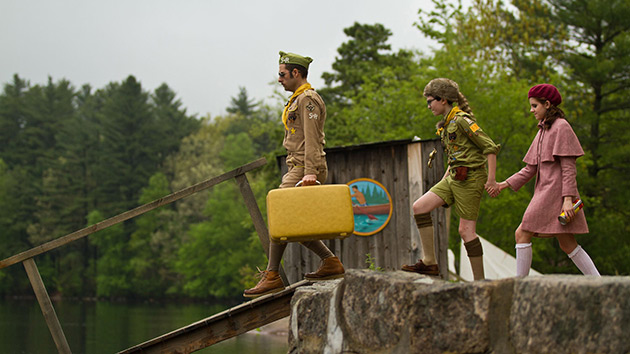Rolling Film, Shooting with Kids, and Pushing it Farther in the DI
Wes Anderson’s latest movie, Moonrise Kingdom, takes audiences on an adventure with pre-teen lovers — newcomers Jared Gilman and Kara Hayward star alongside an adult cast that includes Frances McDormand, Edward Norton, Bruce Willis, Tilda Swinton, and Bill Murray.
Over the course of seven features and a series of clever commercials, Anderson has built up a legion of admirers that includes Martin Scorsese, who said in Esquire back in 2000 that “Wes Anderson, at age 30, has a very special kind of talent: He knows how to convey the simple joys and interactions between people so well and with such richness.” Anderson’s credits include Bottle Rocket, Rushmore, The Royal Tenenbaums, The Life Aquatic with Steve Zissou, The Fantastic Mr. Fox, and The Darjeeling Limited. He is known to study the films of Hal Ashby, Satyajit Ray and Jacques Tati, among others, and tends to work repeatedly with many cast and crewmembers, most notably Owen Wilson and Murray, whose career gained a jolt from the success of Rushmore, Anderson’s breakthrough effort in 1998.
Another key collaborator is cinematographer Robert Yeoman, ASC (Drugstore Cowboy, Get Him to the Greek, Bridesmaids). Yeoman has photographed all of Anderson’s live-action features, often in 35mm anamorphic widescreen and with a strong preference for a 40mm lens. This time, the filmmakers chose the smaller-gauge Super-16 format, in part because the less-wide 1.85:1 aspect ratio seemed appropriate to the more vertically oriented woodland setting. After several film tests, they settled on Kodak VISION3 200T 7213 color film stock.
Anderson’s inspirations for this film reportedly included the Ken Loach film Black Jack, Alan Parker’s feature debut Melody, and the Francois Truffaut film Small Change. His idiosyncratic style grows out of innumerable decisions about framing, focal length, color and editing. “Wes is a true auteur in the sense that it all comes out of him,” says Yeoman. “He is concerned with every detail. You can ask him any question and he will have a distinct answer. He has a very particular and strong sense of every aspect – visually, dramatically, sound design, et cetera. My goal is to get his vision on film, and to enhance when I can.”
The early choice of shooting Super 16 had an impact on almost all subsequent decisions made by the filmmakers, but that was fine with Yeoman, who shot the 2005 family drama The Squid and the Whale in the format.The production gravitated toward two different cameras — the Aaton Xterà was the primary camera, but the smaller Aaton A-Minima came in handy for some shots in the woods and in tight locations (like canoes). Zeiss Superspeed prime lenses were the workhorses, and a Canon 11mm-165mm zoom came in handy.
Gilman (left) and director Wes Anderson.
Because the Xterà accepts 800-foot magazines, Anderson and Yeoman could shoot for more than 20 minutes without reloading, which allowed Anderson to keep the camera rolling between takes, rather than cutting. "That's something we've done from the beginning," Yeoman says, noting that the technique came in especially handy with this film's young and inexperienced lead actors.
The extra time with the young stars paid off – a decent portion of the resulting footage ended up in the final cut, and the deadpan performances of the kids ring true. “It was interesting for me to see Jared and Kara mature as actors and become familiar with the process,” Yeoman observes. “At first, they were struggling a bit and Wes worked with them extensively, but they came a long way in the course of making the film. Their performances were very real and convincing. That time spent with just the kids early on helped us maximize the precious time we did have with adult cast.”
In keeping with the simplicity of Anderson’s approach, lighting for most day exteriors shot in natural surroundings consisted almost entirely of white bounce cards. Interiors sometimes required a bit more attention. One example was a church in which Yeoman created ambience with giant overhead tungsten balloons, adding some directional light with 5Ks and 10Ks. Lightning Strikes lighting effects were also used during the storm sequences.
Anderson’s personal approach to composition has implications in the editing room, too. “Wes likes to center-frame the actors, and he often covers dialog scenes with swish-pans rather than cutting,” says Yeoman. “There are also many long dolly shots. He designs the shots so that each part of the story is encapsulated in that one shot. When you shoot like that, there’s not really a place for a cut, though at times he can slip one in on the swish pan. As a result, he almost never cuts shots out of the movie. Everything is very carefully designed, so there really isn’t a tremendous amount of coverage. Pretty much everything that we shoot gets used.”
The digital intermediate was performed at Technicolor – Post Works New York with colorist Tim Stipan. It offered the usual opportunities to match shots that were filmed under different weather conditions, from bright sunlight to cloud cover, but Yeoman says Anderson used the color-correction tools to manipulate the image more than he has before. “For the dramatic ending scene on the roof of the church, Wes decided to desaturate the color and give the scene a bluish feel. With the addition of some vignetting, it almost has an old-time, silent-film feel," Yeoman says. "I encouraged him to keep pushing it.”
Moonrise Kingdom earned the prestigious opening slot at the 2012 Cannes Film Festival, and it rolls out in limited release (New York and Los Angeles) starting today.
Crafts: Shooting
Sections: Creativity
Topics: Feature fix moonrise kingdom robert yoeman super 16 wes anderson
Did you enjoy this article? Sign up to receive the StudioDaily Fix eletter containing the latest stories, including news, videos, interviews, reviews and more.











